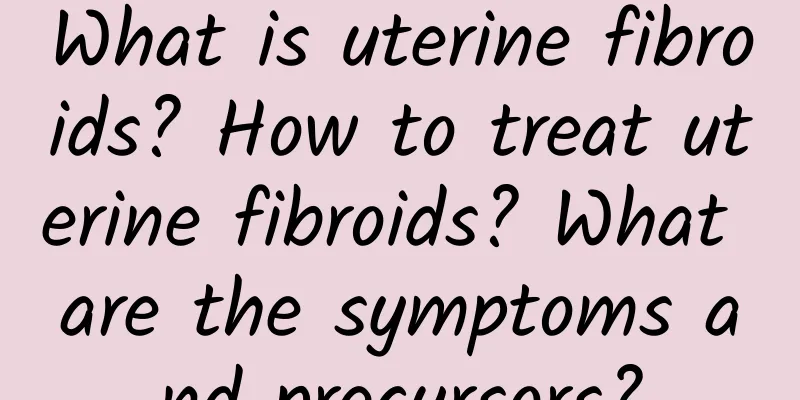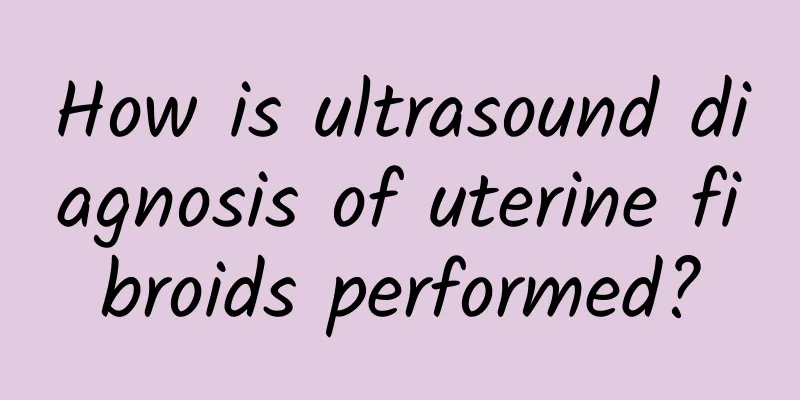What is uterine fibroids? How to treat uterine fibroids? What are the symptoms and precursors?

|
What are uterine fibroids and how to treat them? Uterine fibroids are a common female disease. They are lumps formed by the growth of smooth muscle cells on the wall of the uterus. Uterine fibroids are benign tumors that usually do not turn into malignant tumors. However, they may cause a series of symptoms and discomfort that affect women's quality of life. It is very important for women to understand the symptoms and signs of uterine fibroids, as well as their treatment methods. The symptoms and signs of uterine fibroids may vary depending on the size and number of tumors. Some common symptoms include changes in the menstrual cycle, such as heavy or irregular menstruation, and dysmenorrhea. Some women may feel bloating or pressure in the lower abdomen. If the uterine fibroids enlarge and press on the bladder, it may cause frequent urination or difficulty urinating, or even urinary incontinence. In addition, uterine fibroids may also cause pain or discomfort during sexual intercourse. Although the symptoms of uterine fibroids are obvious, not all patients will experience symptoms. Some women may have uterine fibroids without realizing it, and they are only discovered during a gynecological examination. Therefore, regular gynecological examinations are very important for early detection of uterine fibroids. The treatment method for uterine fibroids depends on the patient's age, symptoms, and the size of the tumor. For patients without obvious symptoms, doctors usually choose to observe and follow up regularly to ensure that the tumor does not grow or cause other complications. For patients with symptoms, treatment options may include medication, surgery, and other treatments. Medication mainly uses drugs to reduce the size of uterine fibroids and relieve related symptoms. One of the commonly used drugs is progesterone analogs, which can inhibit the growth of the endometrium and thus shrink the tumor. Surgical treatment methods include uterine myomectomy, uterine fibroid removal, etc. For patients, choosing a treatment method that suits them needs to be decided based on their own situation and the doctor's advice. Uterine fibroids are a common female disease, but not all patients have symptoms. For patients with symptoms, medication and surgery are common treatments. However, each patient's situation is different, and the treatment method that suits them needs to be decided under the guidance of a doctor. Uterine fibroids are a common gynecological disease, a mass formed by the growth of smooth muscle cells on the wall of the uterus. Although it is a benign tumor that will not turn into a malignant tumor, it may cause a series of symptoms and discomfort. The specific method of treating uterine fibroids depends on the patient's situation and the doctor's advice. Medication and surgery are common treatments. Therefore, early detection and treatment of uterine fibroids is very important for women. Regular gynecological examinations are an important way to detect uterine fibroids early, so women should have regular gynecological examinations to ensure their health. |
Recommend
What causes uterine fibroids? Are uterine fibroids considered benign tumors?
Uterine fibroids are very common in women aged 30...
It’s not your fault that you’re greedy! Your gluttony may be caused by bad intestinal bacteria "dirty fat bacteria"
Traditional Chinese medicine believes that if you...
What to do about dry vagina during menopause? See what the doctor says
Women find that their vagina is dry during menopa...
How to cure uterine fibroids
Uterine fibroids are the most common benign tumor...
Experts talk about the cost of painless abortion
Many people want to know the cost of painless abo...
Timely detection of symptoms of cervical erosion can help patients
Nowadays, more and more people are suffering from...
Is the cost of treating uterine effusion high?
Uterine effusion is a very common gynecological d...
What tests do women need to do for cervical erosion? Women do two types of tests to confirm cervical erosion
Speaking of cervical erosion, many people are fam...
What to do if you have endometriosis pain
For many women nowadays, they always suffer from ...
Three common clinical manifestations of vulvar leukoplakia
The clinical manifestations of vulvar leukoplakia...
Is functional uterine bleeding harmful to the body?
Dysfunctional uterine bleeding is very harmful to...
What are the clinical manifestations of irregular menstruation?
Irregular menstruation is a common gynecological ...
What are the causes and symptoms of benign ovarian cysts?
I don’t know if female friends have heard of beni...
Is there any medicine to treat miscarriage?
Women must learn to love themselves. The temptati...
Frequent abdominal pain and diarrhea? The famous director teaches you to drink "this cup" to easily stop diarrhea and help defecation
Some people are born with weak stomachs and intes...









